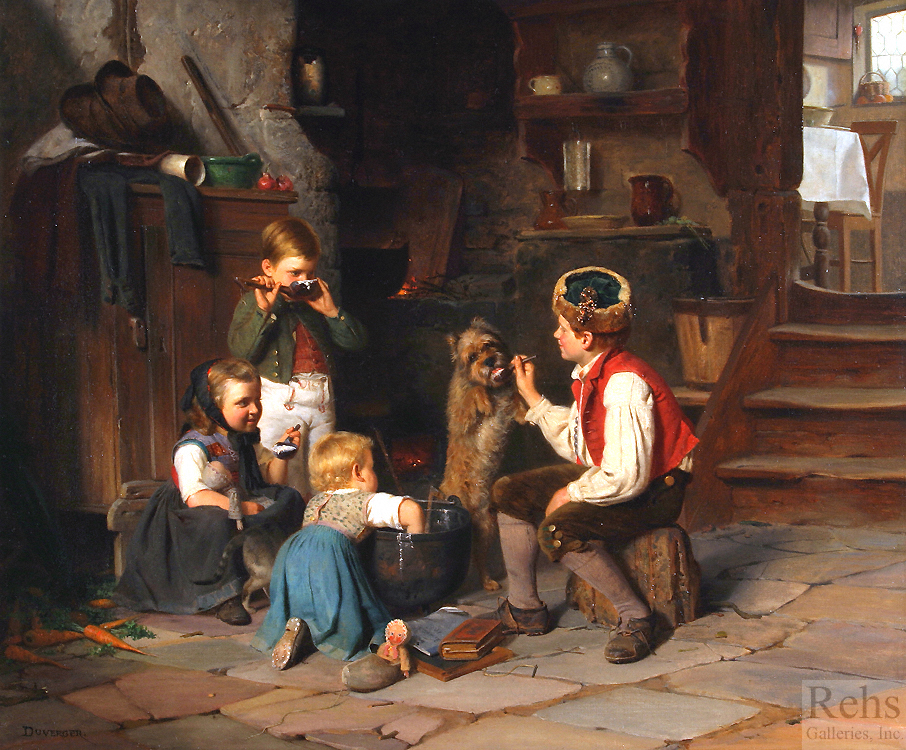Théophile Emmanuel Duverger
(1821 - 1898)
The Meal
Oil on canvas
20 5/8 x 24 1/4 inches
Signed
BIOGRAPHY - Théophile Emmanuel Duverger (1821 - 1898)
Sympathetic genre scenes, especially those including children, proliferated during the mid-nineteenth century in France, often finding their inspiration in 17th-century Dutch paintings. Artists combined the experience of the Realist painters and their depiction of scenes from everyday life – without the occasional grittiness of their depictions – with the increasing interest in children to generate a series of charming images evoking the pleasant simplicity of rustic life. Théophile-Emmanuel Duverger, like Benjamin Eugene Fichel, contributed to this genre tradition, creating sentimental and nostalgic images that continue to retain their appeal for today’s audience.
Théophile-Emmanuel Duverger was born in Bordeaux, France, on September 17, 1821. Duverger was an exceptional character since he was an autodidact, skipping the formal training taken by many of his contemporary artists who also found success at the Parisian Salon. Instead, Duverger relied on his artistic inclinations based on his experience with nature, especially during his time at Ecouen, as well as his understanding of other painters whose works he may have seen while visiting museums. This type of personal training had its benefits since one could follow whatever path they desired instead of being brought into the occasionally tumultuous world of the Parisian ateliers, where rivalries often ran rampant and occasionally polarized the art community.
While Bordeaux did have its own art scene, Duverger relocated to the art colony of Ecouen, started by Pierre Edouard Frère, in the Seine-et-Oise region near Paris, where Duverger eventually found success at the Salon and later commissions. The Ecouen colony boasted many other artists, including Auguste-Frederic-Albert Schenk, Jules-Jacques Veryrasset, Emile Lambinet, Emile-Louis Vernier, and Andre-Henri Dargelas, among several others. Duverger was Dargelas’ father-in-law, and their work shows many similar tendencies. Duverger may have been inspired by Frère’s compositions which also focused on depicting the home, family, and especially children. Ecouen, just eight miles outside of Paris, was the perfect location for artists to retreat from the bustling city and maintain close ties with the Salon.
Duverger began exhibiting at the Salon at a critical time – 1846, even before the Salon was held in the Louvre and just two years before the 1848 Revolution, when Parisians took to the streets in revolt against the corrupt government of the July Monarchy. Duverger’s images were far removed from the grim reality of the social and political scene in Paris at this time and instead focused on the cheerful nature of family life in rural France. But this imagery evolved only over time, and in his early years, he began his public showings with portraiture. His debut painting at the Salon of 1846 was Portrait de Mlle. Z…D… (Portrait of Mademoiselle Z…D…).
After the 1848 Revolution, France ushered in the Second Republic and later the Second Empire. Duverger’s charming and unchallenging imagery found a ripe audience during this period of the Second Empire in Paris. A Time when an increasing middle class began to seek out artists and imagery that had removed itself from the heavily academic interests of many of the other Salon artists still practicing historical or mythological painting. It was not until the early 1850s that Duverger moved away from exhibiting portraiture at the Salon to paintings that were more representative of the style now commonly associated with him. In 1861, fifteen years after first exhibiting at the Salon, Duverger earned his first award; a third-class medal for his numerous showings, including La Gamelle du Grand Papa (The Mess Tin of Grandfather), L’Attente (The Wait), L’Echard (The Splinter), La Convalescence, (The Convalescence), Les Dames de Charité (Women of Charity). In 1863 he received an honorable mention, and in 1865 he received a second medal for Le Paralytique (The Paralytic) and Le Laboureur et Ses Enfants (The Worker and His Children). The Salon critic, Louis Auvray, was taken with the latter painting and wrote in his Salon review, Exposition des Beaux-Arts: Salon de 1865, that:
The painting of the worker and his children, by Mr. Duverger, is a composition that touches you profoundly. The worker, feeling that life is leaving him, brings together his children around his bed, and, holding out his hand to his oldest son, begs him to return to his duty. The child, with his head down, overwhelmed by the reproach, struggles internally against his negative bents, which he tries to dominate to promise a return to the better. But his wife, who is breast-feeding her last child, appears to doubt that there will be any change possible to her husband’s bad behavior.
Duverger also submitted his work to the 1889 Exposition Universelle in Paris, where he received a bronze medal. In 1893 his painting L’Intempérance (Intemperance) was shown at the 1893 Columbian Exposition in Chicago. Duverger continued submitting his work to the Salon until 1898. Towards the end of his career, he, like many other artists, began exhibiting drawings and paintings, but for his last work, Duverger exhibited the painting Allant aux Champs (Going to the Fields). He died on August 25, 1898.
Duverger showed a range of capabilities in his choice of imagery, ranging from the most well-known cheerful scenes of domestic life, but also knew how to speak to a more aristocratic audience with works that concentrated on the luxury of idleness and the splendor of interior settings. Examples of his work can now be found in the Musée des Beaux Arts, Bordeaux; Le Musée Artistique et Archéologique, La Roche-sur-Yon, and the London Guildhall Art Gallery.

